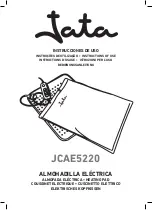
OPERATION
OPERATION INSTRUCTIONS
ASSEMBLY INSTRUCTIONS
WARNING:
This product contains small batteries.
Swallowed small batteries can cause CHOCKING
HAZARD.Seek immediate medical attention if
batteries are swallowed or inhaled. Keep children
away from the small batteries.
Do not store a spare LP-gas cylinder under or near this appliance;
Never fill the cylinder beyond 80 percent full;
Place the dust cap on the cylinder valve outlet whenever the cylinder is not
in use. Only install the type of dust cap on the cylinder valve that is provided with
the cylinder valve. Other type of caps or plugs may result in leakage of propane.
A dented, rusted or damaged propane cylinder may be
hazardous and should be checked by your cylinder
supplier. Never use a propane cylinder with a damaged
valve connection.
The cylinder must have a listed overfilling prevention
device. The cylinder must have a connection device
compatible with the connection for the appliance. The
cylinder used must include a collar to protect the
cylinder valve. Never connect an unregulated propane
cylinder to the heater.
The propane cylinder must be constructed and marked
in accordance with the specifications for LP gas
cylinders of the U.S. Department of Transportation
(DOT) or the standard for cylinders, spheres and
tubes for transportation of dangerous goods and
commission, CAN/CSA-B339.
Standard 20 lb. tank
12.2 in. / 31cm
17.9 in. / 45.5cm
The knob on the LP tank must be closed. Make sure that
the knob is turned clockwise to a full stop. The
cylinder supply system must be arranged for vapor
withdrawal. Check that the control knob on the control
unit is turned off. Hold the regulator in one hand and
insert the nipple into the valve outlet. Be sure the nipple
is centered in the valve outlet. The coupling nut connects
to the large outside threads on the valve outlet.
Hand-tighten the coupling nut clockwise until it comes
to a full stop. Firmly tighten by hand only.
To Disconnect:
Fully close the tank valve by turning
clockwise. Turn the coupling nut counterclockwise
until the regulator assembly detaches.
To check for a leak:
1. Make 2-3 oz. leak check solution (one part
liquid dishwashing detergent and three parts
water).
2. Apply several drops of solution where
regulator connects to cylinder and to all hose
and valve connections
3. Make sure all patio heater and light valves
are OFF.
4. Turn cylinder valve ON.
If bubbles appear at any connection, there is a
leak.
1. Turn cylinder valve OFF.
2. If leak is at regulator/cylinder valve connection:
Disconnect, reconnect, and perform another
leak check. Apply the soapy solution to all hose and
valve connections. If you continue to see bubbles
after several attempts, cylinder valve is defective
and should be returned to cylinder’s place of
purchase.
3. If leak is at hose/regulator connection:
This part is defective and you should contact the
customer service department for replacement.
If NO bubbles appear at any connection, the connections are secure.
NOTE:
Whenever gas connections are loosened or removed, you must perform a complete leak test.
WARNING
• Perform all leak tests outdoors.
• Extinguish all open flames.
• NEVER leak test when smoking.
• Do not use the heater until all connections have been
leak tested and do not leak.
Regulator / Cylinder
connection
DANGER
Caution:
Do not attempt to operate until you have read and understand all General Safety Information
in this manual and all assembly is complete and leak checks have been performed.
This appliance shall be used only in a well-ventilated space and shall not be used in a building,
garage or any other enclosed area.
An appliance may be installed with shelter no more inclusive than:
1)With walls on all sides, but with no overhead cover.
m
o
r
f
)
"8
4
(
m
2
.
1
f
o
e
c
n
a
r
a
e
l
c
a
n
i
a
t
n
i
a
m
s
y
a
w
l
A
combustible materials from the top and side.
2)Within a partial enclosure which includes an overhead cover and no more than two side walls. These
side walls may be parallel, as in a breezeway, or at right angles to each other.
3)Within a partial enclosure which includes an overhead cover and three side walls, as long as 30
percent or more of the horizontal periphery of the enclosure is permanently open.
W
A
LL
120 cm
120 cm
CEILING






































